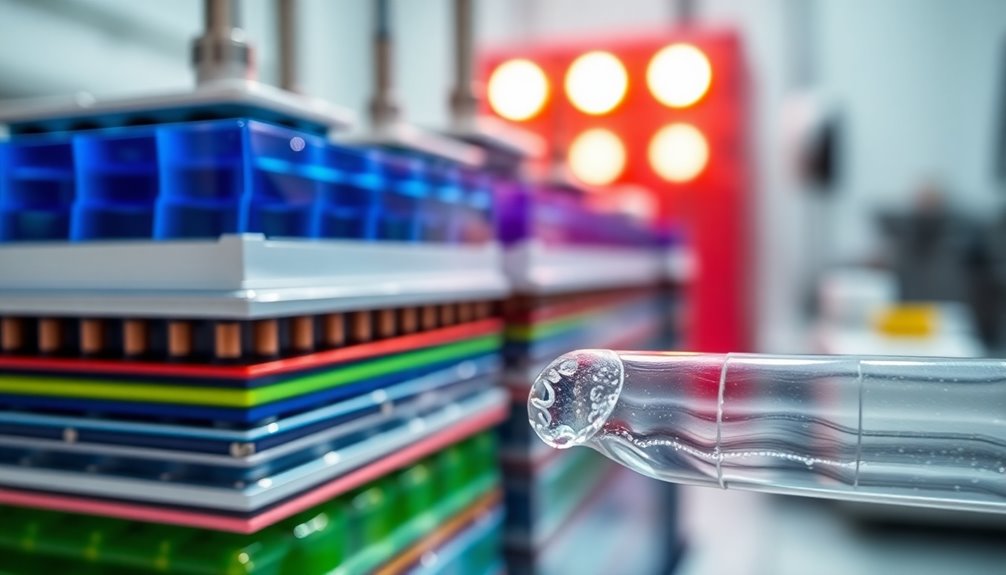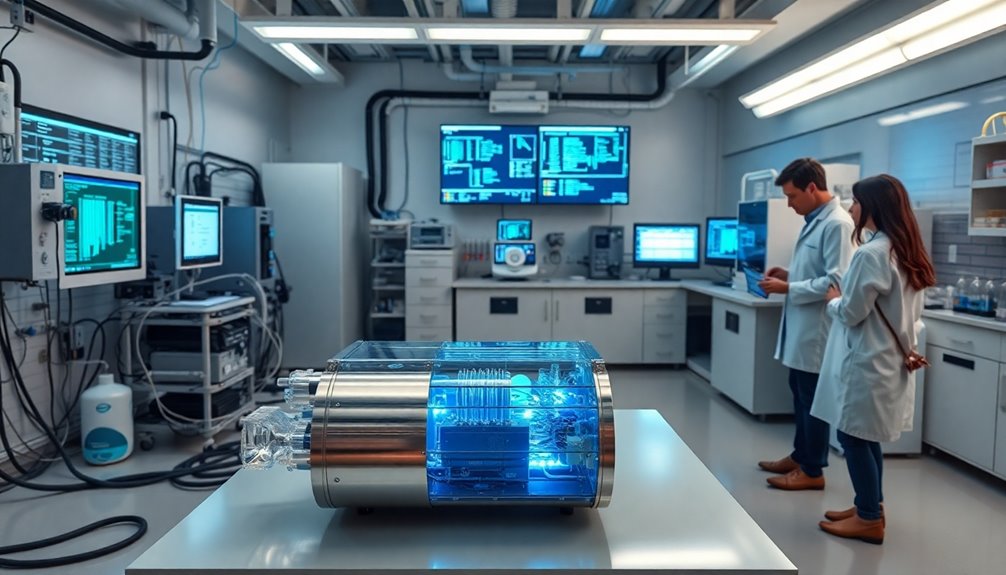Unitized regenerative fuel cell (URFC) technology faces key hurdles like high manufacturing costs and complex water management. Despite these challenges, significant progress has been made since the late 1990s, including impressive efficiency ratings and potential applications in energy storage and remote power systems. As manufacturers work on cost-effective production methods, the promise of URFC technology continues to grow. There's much more to discover about its transformative potential and ongoing advancements.
Key Takeaways
- Water management issues significantly affect the efficiency and performance of URFCs, requiring innovative solutions for effective transport and separation.
- High manufacturing costs remain a barrier to widespread adoption, necessitating cost-effective production methods for manufacturers.
- Structural complexity must be managed to ensure integration while maintaining space efficiency in URFC designs.
- Current round trip efficiencies of 37% show promise, but URFC technology is still primarily in the experimental phase for commercial applications.
- With potential applications in remote power systems and energy storage, addressing existing hurdles is crucial for realizing URFC technology's transformative capabilities.

Unitized Regenerative Fuel Cell (URFC) technology is revolutionizing energy storage by combining the functions of a fuel cell and an electrolyzer into a single unit. This integration allows you to convert water into hydrogen and oxygen through electrolysis and then recombine them to generate electricity, making URFCs a game-changer in energy systems. Key components like the proton exchange membrane and gas diffusion layers work together to enhance efficiency, reducing system complexity and cost.
However, you'll encounter several technical challenges that must be addressed for URFCs to reach their full potential. Water management is critical; efficient transport and separation of water are essential for both electrolysis and fuel cell operations. High manufacturing costs present another significant barrier to widespread adoption, making it crucial for manufacturers to seek cost-effective production methods. Additionally, the structural complexity of URFC designs must balance component integration with the need for space efficiency and structural integrity.
Technical challenges like water management and high manufacturing costs must be overcome for URFCs to achieve their potential.
Historically, the development of URFCs dates back to the late 1990s, with pioneers like Fred Mitlitsky exploring reversible fuel cell technology. Early prototypes demonstrated impressive durability, achieving thousands of cycles with minimal degradation. Companies such as Hydrogenics Corp. have actively engaged in patenting URFC innovations, while government support from NASA and the Department of Energy has fueled research efforts. Notably, NASA funding played a critical role in advancing the Helios project, which integrated URFC technology.
Despite these advancements, URFCs remain largely in the experimental phase for commercial applications. Performance metrics show promise, with technologies achieving round trip efficiencies of 37% and systems tested at power ratings like 18.5 kW. Recharge times align closely with fuel cell operation durations, enhancing their practicality.
With higher energy densities due to reduced reactant storage needs, URFCs are positioned to play a vital role in remote area power systems and other energy storage applications. Addressing the hurdles ahead will be essential for realizing the full capabilities of this transformative technology.
Frequently Asked Questions
What Are the Potential Applications of Unitized Regenerative Fuel Cells?
Unitized regenerative fuel cells (URFCs) have exciting potential applications.
You can use them for efficient energy storage, providing up to 60% round-trip efficiency, making them ideal for long-term solutions. They also work well in remote area power systems, reducing costs and integrating seamlessly with solar and hydrogen sources.
In addition, URFCs support green hydrogen production and power generation, promoting independence from fossil fuels while contributing to cleaner energy solutions.
How Do Unitized Regenerative Fuel Cells Compare to Traditional Energy Storage Systems?
When you compare unitized regenerative fuel cells (URFCs) to traditional energy storage systems, you'll find URFCs offer lower capital costs and pollution-free operation.
They're compact and space-efficient, making them ideal for various applications.
However, they typically have lower round-trip efficiency and face challenges with hydrogen storage and technological complexity.
While URFCs present promising advantages, traditional batteries often outperform them in efficiency and readiness for widespread implementation.
What Is the Expected Lifespan of Unitized Regenerative Fuel Cells?
Imagine a sturdy bridge, standing strong against time's relentless flow.
That's similar to the expected lifespan of unitized regenerative fuel cells (URFCs), which can endure around 10,000 charge-discharge cycles with minimal degradation.
They're engineered to thrive under optimal conditions, like a well-tuned engine, with advanced materials ensuring durability.
With ongoing innovations in design and efficiency, URFCs hold promise for long-term energy storage, making them a potential cornerstone in sustainable technology.
Are There Any Safety Concerns With Unitized Regenerative Fuel Cells?
Yes, there are safety concerns with unitized regenerative fuel cells (URFCs).
You need to be aware of risks related to hydrogen-oxygen mixtures and pressure control, which can lead to accidents if mishandled.
Additionally, material degradation and water management issues can affect performance and safety.
Proper design and monitoring systems are essential to prevent leakage and electrical shorting.
Ensuring robust safeguards will help mitigate these safety risks during operation.
How Does the Efficiency of Unitized Regenerative Fuel Cells Vary With Temperature?
Imagine a garden where flowers thrive at a perfect temperature. Similarly, unitized regenerative fuel cells (URFCs) flourish around 80°C.
At this sweet spot, you can witness round-trip efficiencies soar to 60%. However, stray too far from this ideal temperature, and the blooms start wilting—efficiency drops, and durability suffers.
Conclusion
In the journey toward sustainable energy, unitized regenerative fuel cell technology stands as a bridge, linking promise with potential. While challenges may loom like shadows, each hurdle you encounter is a stepping stone, guiding you closer to a brighter horizon. Embracing innovation and perseverance, you're not just witnessing progress; you're fueling a revolution. As you navigate this landscape, remember: every drop of effort contributes to the rising tide of a cleaner, more efficient future.









